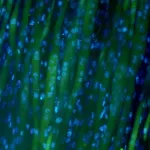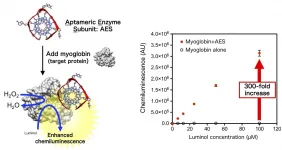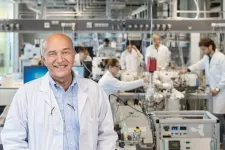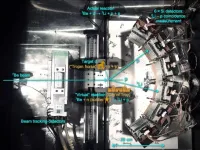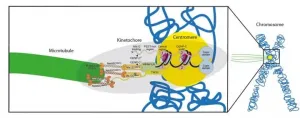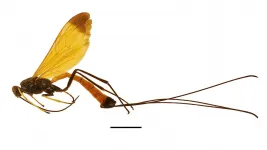A remote laboratory for performing experiments with real electronic and communications equipment
Hundreds of students have used this technological solution in the UOC's Faculty of Computer Science, Multimedia and Telecommunications
2021-07-01
(Press-News.org) Laboratories are an inherent part of technology qualifications, as practical experiments are essential for students to acquire the competencies and skills that they will need during their future professional development. Providing this learning in a virtual format is one of the challenges posed by the current COVID-19 pandemic--a challenge that distance universities have been addressing for years. RLAB-UOC is a remote laboratory designed and developed by the Universitat Oberta de Catalunya (UOC) that enables students in the Faculty of Computer Science, Multimedia and Telecommunications to conduct practical experiments with real electronic and communications equipment anywhere, at any time. A new article published in the scientific journal Electronics has described the characteristics of the laboratory, and analysed the students' satisfaction using a type of experiment that has taken place over the past six semesters.
"The main results show that the students' opinions are very positive, and that it is feasible to do remote experimentation with highly complex and expensive equipment and devices, like those in electronics and communications laboratories, in a 100% online environment, integrating the theory and practical classroom in the same environment. This improves the learning experience and the students acquire the practical and professional skills they need," pointed out Carlos Monzo, a researcher in the Faculty of Computer Science, Multimedia and Telecommunications at the UOC, and the leading author of the study. Other researchers and members of faculty also took part in the research: Germán Cobo, David García, José Antonio Morán and Eugènia Santamaria.
Controlling an electronic circuit remotely
The case study of the RLAB-UOC, which has been used by hundreds of students since its inception in 2012, was carried out for Digital Electronics, an advanced course on the Bachelor's Degree in Telecommunications Technologies and Services Engineering (GETiST). In specific terms, it is based on an experiment with a circuit controlled by an FPGA, a programmable electronic device physically located at the UOC. Students can connect from anywhere with an internet connection, using a control program to access a real FPGA board and work remotely with the circuit, while viewing the results of their work via a webcam.
The students subsequently answered a questionnaire to rate the perceived quality and usefulness of the remote laboratory and their opinion of the use of real instruments compared to the simulations that are also used in other experiments during the course. The results of the survey show that students rate the laboratory and working with real tools "very positively". They also think that it would be useful to extend the use of this laboratory to other courses.
Creating this feeling of being immersed in a real task was one of the most important challenges in the development of this technology. "The study shows a specific example which presents the structure of a subject where theory and practice exist side by side, and the students rate it very positively. It was also very important for us to prevent the feeling from being similar to working with a simulation, which we achieved with the design of the laboratory and the experiments carried out," stressed the researcher.
A patented technology
The development of this remote laboratory has been accompanied by a patent to protect a technology for carrying out a type of experiment primarily related to the design and assembly of analogue electronics circuits in a fully online environment. "Its main characteristics are that it enables elements with two and three poles (resistors, capacitors, coils, transistors, etc.) to be connected automatically and remotely, which gives students the flexibility to perform the assemblies they want virtually. The invention also allows the possible experiments to be scaled, so that the system can be expanded," said the researcher.
The types of experiments that have been performed have evolved over time and they have been changed, updated or created to meet the students' academic needs. "The aim is to be able to offer the most advanced qualifications with experimental needs, taking into account the completely remote nature of our studies," pointed out the researcher.
Home laboratories
The UOC also offers other alternatives in order to address this need to carry out practical experiments: virtual simulations and home labs. "When physical access to the devices is required, the student is sent equipment like Lab@Home. This is another UOC invention, in which the student can manipulate electronic devices and components in situ, and it has also been highly rated by students, as we showed in another recent article," concluded Carlos Monzo.
INFORMATION:
This research by the UOC promotes Sustainable Development Goal (SDG) 4 (Quality Education).
UOC R&I
The UOC's research and innovation (R&I) is helping overcome pressing challenges faced by global societies in the 21st century, by studying interactions between technology and human & social sciences with a specific focus on the network society, e-learning and e-health. Over 500 researchers and 51 research groups work among the University's seven faculties and two research centres: the Internet Interdisciplinary Institute (IN3) and the eHealth Center (eHC).
The United Nations' 2030 Agenda for Sustainable Development and open knowledge serve as strategic pillars for the UOC's teaching, research and innovation. More information: research.uoc.edu. #UOC25years
[Attachments] See images for this press release:
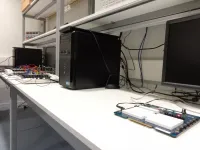
ELSE PRESS RELEASES FROM THIS DATE:
2021-07-01
Near-death experiences are known from all parts of the world, various times and numerous cultural backgrounds. This universality suggests they may have a biological origin and purpose, but exactly what this could be has been largely unexplored.
A new study conducted jointly by the University of Copenhagen (Denmark) and the University of Liege (Belgium) and published in Brain Communications shows how near-death experiences in humans may have arisen from evolutionary mechanisms.
"Adhering to a preregistered protocol, we investigated the hypothesis that thanatosis is the evolutionary origin of near-death experiences", says Daniel Kondziella, a neurologist from Rigshospitalet, Copenhagen University Hospital.
When attacked by a predator, as a last resort defense mechanism, ...
2021-07-01
An affordable lab system that uses grass blades to turn cells into cultured meat has been developed at the University of Bath in the UK.
Researchers have successfully taken grass from the university's campus and used it to create a scaffold that animal cells can attach to and grow on. The resulting tissue has the potential to be used both as lab-made meat and as human muscle tissue to repair or replace tissue which has been damaged or lost through injury or disease.
The study, by Dr Paul De Bank (Department of Pharmacy & Pharmacology), Professor Marianne Ellis (Department of Chemical Engineering) and Scott Allan (a PhD researcher in the Department of Chemical Engineering), is published in this month's Journal of ...
2021-07-01
RUDN University chemists have proposed a new method of producing fuel from Jatropha Curcas, a poisonous tropical plant. Natural minerals and a non-toxic additive from vegetable raw materials are used for that. The reaction efficiency is 85%. The fuel can be used in diesel internal combustion engines. The results are published in the International Journal of Green Energy.
Jatropha Curcas is a common plant in many tropical regions. Its seeds contain lots of oil, but they cannot be used agriculture because the oil contains toxins that are dangerous for people and animals. But the composition of jatropha oil is suitable for the manufacture of biodiesel. One of challenge of the processing the plant raw materials is to select sufficiently ...
2021-07-01
PROVIDENCE, R.I. [Brown University] -- Researchers from Brown University and MIT have developed a new data science framework that allows users to process data with the programming language Python -- without paying the "performance tax" normally associated with a user-friendly language.
The new framework, called Tuplex, is able to process data queries written in Python up to 90 times faster than industry-standard data systems like Apache Spark or Dask. The research team unveiled the system in research presented at SIGMOD 2021, a premier data processing conference, and have made the software freely available to all.
"Python is the primary programming language used by people doing data science," said Malte Schwarzkopf, an assistant professor of computer ...
2021-07-01
A collaboration led by Distinguished Professor Dr. Kazunori Ikebukuro from Tokyo University of Agriculture and Technology (TUAT), Japan, discovered that G-quadruplex (G4)-forming DNA binds myoglobin through a parallel-type G4 structure. Through the G4 binding, the enzymatic activity of myoglobin increases over 300-fold compared to that of myoglobin alone (Figure). This finding indicates that DNA may work as a carrier of genetic information in living organisms and act as a regulator of unknown biological phenomena.
"Aptamers" are nucleic acid-based synthetic ligands that can be used against many target molecules with high affinity and specificity. Some aptamers that bind to proteins ...
2021-07-01
Zeolites are extremely porous materials: Ten grams can have an internal surface area the size of a soccer field. Their cavities make them useful in catalyzing chemical reactions and thus saving energy. An international research team has now made new findings regarding the role of water molecules in these processes. One important application is the conversion of biomass into biofuel.
Fuel made from biomass is considered to be climate-neutral, although energy is still needed to produce it: The desired chemical reactions require high levels of temperature and pressure.
"If ...
2021-07-01
WASHINGTON -- If you've ever tried to capture a sunset with your smartphone, you know that the colors don't always match what you see in real life. Researchers are coming closer to solving this problem with a new set of algorithms that make it possible to record and display color in digital images in a much more realistic fashion.
"When we see a beautiful scene, we want to record it and share it with others," said Min Qiu, leader of the Laboratory of Photonics and Instrumentation for Nano Technology (PAINT) at Westlake University in China. "But we don't want to see a digital photo or video with the wrong colors. Our new algorithms can help digital camera and electronic display developers better adapt their ...
2021-07-01
There is a significant discrepancy between theoretical and observed amounts of lithium in our universe. This is known as the cosmological lithium problem, and it has plagued cosmologists for decades. Now, researchers have reduced this discrepancy by around 10%, thanks to a new experiment on the nuclear processes responsible for the creation of lithium. This research could point the way to a more complete understanding of the early universe.
There is a famous saying that, "In theory, theory and practice are the same. In practice, they are not." This holds true in every academic domain, but it's especially common in cosmology, the study of the entire ...
2021-07-01
A wonder of nature
As a human cell begins division, its 23 chromosomes duplicate into identical copies that remain joined at a region called the centromere. Here lies the kinetochore, a complicated assembly of proteins that binds to thread-like structures, the microtubules. As mitosis progresses, the kinetochore gives green light to the microtubules to tear the DNA copies apart, towards the new forming cells. "The kinetochore is a beautiful, flawless machine: You almost never lose a chromosome in a normal cell!", says Musacchio. "We already know the proteins that constitute it, yet important questions about how the kinetochore works are still open: How does it rebuild itself during chromosome replication? ...
2021-07-01
Researchers at the Biodiversity Unit of the University of Turku, Finland, study insect biodiversity particularly in Amazonia and Africa. In their studies, they have discovered hundreds of species previously unknown to science. Many of them are exciting in their size, appearance, or living habits.
"The species we have discovered show what magnificent surprises the Earth's rainforests can contain. The newly discovered Dolichomitus meii wasp is particularly interesting for its large size and unique colouring. With a quick glance, its body looks black but glitters electric blue in light. Moreover, its wings are golden yellow. Therefore, you could say it's like a flying jewel," says Postdoctoral Researcher Diego Pádua from the Instituto Nacional ...
LAST 30 PRESS RELEASES:
[Press-News.org] A remote laboratory for performing experiments with real electronic and communications equipment
Hundreds of students have used this technological solution in the UOC's Faculty of Computer Science, Multimedia and Telecommunications

